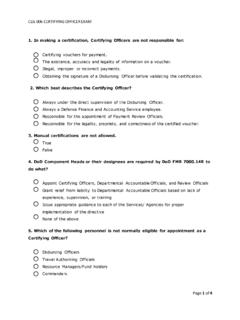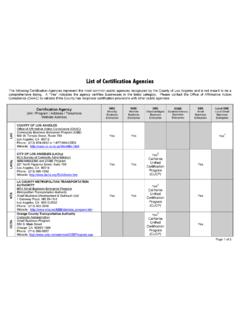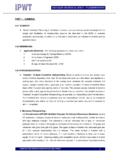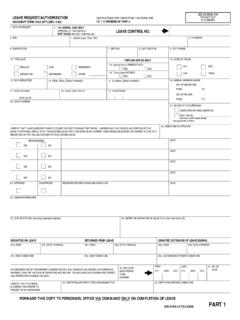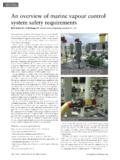Transcription of U.S. DEPARTMENT OF HOUSING AND URBAN …
1 1 DEPARTMENT OF HOUSING AND URBAN DEVELOPMENT Office of Public and Indian HOUSING Special Attention of: Regional and Field Office Directors of Public HOUSING Public HOUSING Agencies Regional Administrators Responsible Entities Notice PIH 2016- 22 HA) Issued: December 5, 2016 This notice remains in effect until amended, superseded or rescinded. Cross Reference: PIH 2013-07 CPD Notice 16-02 SUBJECT: Environmental Review Requirements for Public HOUSING Agencies 1. Purpose. This notice provides information and guidance regarding Public HOUSING Agencies (PHAs) compliance with the National Environmental Policy Act of 1969 (NEPA) (42 4321) and other related laws and authorities. This notice clarifies the applicability of environmental reviews under 24 CFR parts 50 and 58 to all PHA activities at project site(s) assisted or to be assisted by HUD and to the use of all HUD funds, including operating funds.
2 This notice also reiterates the prohibition on the obligation or expenditure of any funding without environmental clearance, and presents submission and processing requirements using a five-year submission period as long as there are no changes to the project scope or environmental conditions. Finally, this notice includes a Part 50 programmatic determination for administrative, management, and certain maintenance activities and for HOUSING Choice Voucher (HCV) activities. 2. Background. NEPA requires federal agencies to consider the environmental impact of proposed actions early in the planning and decision-making process to avoid and mitigate negative impacts to human health and the environment. The requirement to secure environmental clearance prior to initiating activities for federally-assisted HOUSING directly supports HUD s goal to provide decent, safe, and sanitary affordable HOUSING .
3 A PHA initiates an environmental review by submitting a complete and clear project description of the activities it anticipates undertaking at an environmental project site over a five-year period to its Responsible Entity under 24 CFR Part 58 (or to HUD under 24 CFR Part 50). The Responsible Entity (RE) reviews the project description and determines the appropriate level of environmental review and, if necessary, requests additional information and studies to complete the review. The extent of the environmental review depends on the nature of the proposed activities and the location of the project. Depending on the results of the analysis, a Responsible Entity may publish a public notice soliciting comments from the community. The Responsible Entity forwards its determination to the PHA if activities are determined to be exempt or 2 categorically excluded, not subject to For all other activities, HUD provides the authority to obligate federal funds after a 15-day waiting period (24 CFR lists the permissible basis for objections to the review).
4 For more information on the environmental review process visit the HUD Exchange. 3. Applicability. Environmental review requirements, as found in 24 CFR Parts 50 and 58 and the related federal laws and authorities, apply (i) to all HUD-funded activities; and (ii) to all HUD assisted or to be HUD assisted project site(s). These include, but are not limited to: Funding Sources a. Operating Fund b. Capital Fund c. MTW Block Grant d. Choice Neighborhoods Grant e. HOPE VI f. Project Based Vouchers (PBV) Program Approvals a. Energy Performance Contract (EPC) program b. Rental Assistance Demonstration (RAD), including pre-development activities c. Section 18 actions, including demolition and/or disposition d. Eminent domain actions e. Retention under 2 CFR 200 f. Homeownership g. Mixed-Finance Public HOUSING Local, non-federal funds to be used at HUD assisted or to be HUD assisted project sites(s) In other words, all planned activities at HUD assisted or to be assisted project sites must receive environmental clearance, unless HUD explicitly states that a funding stream is not subject to environmental review ( , ROSS-SC).
5 Only an RE or HUD may make environmental determinations and provide environmental clearance. PHAs cannot make any final findings or determinations, and cannot take any choice-limiting actions or obligate any funds until they have received environmental clearance. This is true even if it appears that the activity will be determined Exempt. Moving to Work (MTW) agencies do not have any flexibilities or waivers related to environmental review requirements and must receive environmental clearance prior to any acquisition or physical activities (including locally funded activities if the site will receive HUD funding at any point in the future) and prior to obligating MTW Block Grant funding. 4. Definitions. Environmental clearance terms are defined as: a. Activity. An action the PHA puts forth as part of an assisted or to be assisted project. Activities include, but are not limited to, actions related to operations, administration, maintenance, rehabilitation, demolition, or disposition regardless of whether the activity will be funded by federal funding sources or not.
6 3 b. certifying Officer. Official of the Responsible Entity who is authorized to execute the Request for Release of Funds and Certification (RROF) and has the legal capacity to carry out the responsibilities of 24 CFR This function may be delegated by the Responsible Entity s chief executive, but may not be the person who prepared the environmental review or an outside entity. The certifying Officer is almost never an official of the PHA. c. Choice-Limiting Action. Any action in which a PHA commits or expends HUD or non-HUD funds on activities for a project assisted under the HOUSING Act that reduce or eliminate a PHA s opportunity to choose alternatives. Choice-limiting includes actions to acquire, dispose, rehabilitate, demolish, convert, transfer, remove, lease, or construct properties (including entering into contracts or other written commitments).
7 Choice limiting actions performed prior to environmental clearance can result in regulatory or statutory violations that can jeopardize HUD funding of the project. d. Environmental Clearance. The final approval given by the HUD Approving Official. Environmental clearance for Part 50 reviews is the final signature of the HUD Approving Official in HEROS or on the paper Form HUD-4128. Environmental clearance for Part 58 is the final electronic signature of the HUD approving official or the State in HEROS or on the HUD Form , Authorization to Use Grant Funds (AUGF). An environmental clearance is required prior to spending funds or commencing any activity on or at a project site in accordance with 24 CFR part 50 or 58. e. Environmental Determination. Any decision made by the Responsible Entity under 24 CFR Part 58 or HUD under 24 CFR Part 50 regarding compliance with NEPA and related laws and authorities.
8 Each applicable environmental law and authority requires a determination, supported by analysis and documentation. Environmental determination may also refer to the determination of which level of environmental review applies, and to the determination of whether the activity will have a significant impact on the environment. f. Environmental Project Site. A project site consists of buildings or other improvements and parcels of land that logically group together as a single, cohesive setting. For scattered site units, the project site is defined at the neighborhood level, so long as the boundaries of the neighborhood are clearly identified. Since environmental conditions vary from one geographic area to the next, each separate public HOUSING project site is subject to a separate environmental review. A project site may or may not comprise an entire asset management project (AMP) or non-asset management development.
9 G. Environmental Review. The process of reviewing a project and its potential environmental impacts to determine whether it complies with the NEPA and related laws and authorities. h. Grant Funds. For environmental purposes, grant funds include formula-distributed PIH funds under Capital and Operating Fund Programs. 4 i. Maintenance. The term maintenance is defined differently for environmental clearance than for PIH s Capital Fund and Operating Fund programs. For environmental review purposes, maintenance activities slow or halt deterioration of a building and do not materially add to its value or adapt it to new Although minor repairs and replacements are considered operating expenses in accordance with section 9(g) of the United States HOUSING Act of 1937, deferred maintenance and nonroutine maintenance as defined in 24 CFR (b)(5) are generally not maintenance activities for environmental reviews.
10 An example of when nonroutine maintenance would constitute maintenance for environmental purposes is the replacement of refrigerators and stoves (considered nonroutine maintenance for Capital Fund purposes), provided the replacement is not part of a complete or substantial kitchen remodel. Notice CPD 16-02 Guidance for Categorizing an Activity as Maintenance for Compliance with HUD Environmental Regulations, 24 CFR Parts 50 and 58 provides guidance and a table of specific examples. It is essential that project descriptions provide sufficient information for the RE to distinguish between maintenance and rehabilitation activities to avoid NEPA non-compliance. j. Project. An activity, or group of integrally related activities, designed by the PHA or other recipient to accomplish, in whole or in part, a specific objective. k. Project Aggregation. Requirement at 24 CFR to group together and evaluate as a single project all individual activities which are related either on a geographical or functional basis, or are logical parts of a composite of contemplated actions.










